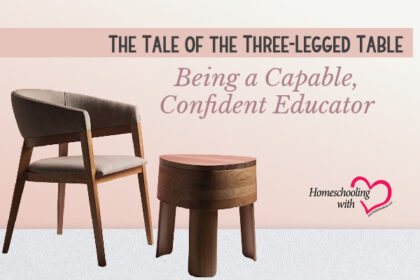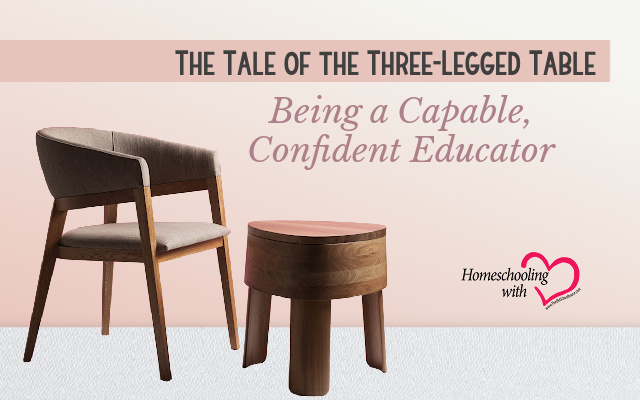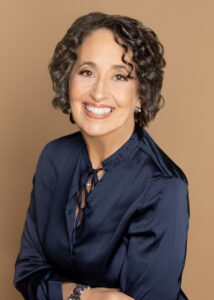The Tale of the Three-Legged Table: Being a Capable, Confident Educator


Today began as every other day. I brewed a cup of coffee, refilled my water bottle, and headed into the den for a quiet time with the Lord. A time of meditation on God’s Word, prayers of praise and supplication, accompanied by morning joe. I sipped the warm elixir from a delicate, magnolia-decorated mug. It awakened and soothed my mind and body for the day ahead.
After a few sips, I placed the mug on the three-legged table located a convenient arm’s length to my left. The pink, marble-topped table has been in my family for many years. My mother purchased it for my daddy to place beverages, books, and a few pens and pencils while he read, studied, or thought. Its purpose is the same for me.
It sat to Daddy’s left, too. He used it many years but not without consternation.
“Miriam,” he often railed when the table tipped. “Three-legged tables aren’t steady. I don’t know why you ever got it.”
I do! It’s lovely. Its knee-height top was slightly below the arm of Daddy’s favorite chair, and its compact diameter fit comfortably beside it. However, the large missing chunk from the marble’s trim testifies that three-legged tables aren’t the most secure.
I often think about how I don’t want to part with this table. I rationalize that it serves its purpose of holding coffee cups and pens yet realize it might also portend a disaster.
What does a three-legged table have to do with being a capable, confident educator?
After a few years of fits and starts as a new homeschooler, I was ready to throw in the towel. I followed the teacher’s guides to my various curriculum to a tee (as best I could!). I tried interesting teaching suggestions in homeschool magazines and books. Listened to well-respected speakers at homeschool conferences and followed their advice.
Prayed a lot.
Still, I felt lost, adrift with no way to know if what I was doing was good, right, or even adequate. I didn’t have a firm handle on what I was doing. I had nothing of consequence to hold on to. No overarching sense of what I was supposed to do.
Education majors are often tasked with a capstone project to establish some sense of who they want to be as an educator. In the assignment, they draw upon coursework and experience to formulate a personal philosophy of education. A summary of personal beliefs, the exercise requires the soon-to-be professional teacher to formulate principles upon which to build and keep their teaching practice strong.
I didn’t do that. To be honest, I had no idea that having foundational principles about teaching and learning could be a life vest for the roughest times I faced with my children. All I wanted to be was the capable, confident teacher my children deserved.
Over time with fervent prayer and focused study, seven fundamental principles about teaching and learning emerged.
The first principle was Get Understanding. Proverbs 4 outlines a righteous father’s instruction to his children. In verse 5, he admonishes them to get understanding along with wisdom and in verse 7 advises that “with all thy getting, get understanding.” (KJV)
For many years, I believed the Get Understanding principle was a three-legged table.
The first leg was to get understanding about my children/students. How they learned, their strengths, and weaknesses.
The second leg was to get understanding about what to teach, the content/subject matter. Initially, I relied on highly recommended curriculum until my children began asking questions it couldn’t answer, or I found gaps that needed to be filled. I learned other ways to get understanding about the content/subject.
The third leg was to get understanding about how to teach. I discovered there are a gazillion types of instructional methods. Some methods were pretty boring to me and my children. Other methods resonated with us and created memorable learning.
For years I thought that students, content, and methods were all I needed to Get Understanding. Then, my table tottered and turned over. Something wasn’t working. So, I followed Proverbs 3:7’s advice and invested a lot of time and assets to achieve fuller understanding about what was missing in my Get Understanding equation.
To my surprise, my three-legged table needed a critical, stabilizing fourth leg. For many decades, research studies into what works in education have affirmed an unequivocal truth: the single most important element in student achievement is the teacher.
So, that meant I had to understand me, too. It’s as important for me to understand and embrace my own strengths and weaknesses as it is to understand my children’s.
It requires a long, hard look at strengths and weaknesses in intellect, academics, memory, and attention. What were my challenges in school that caused me to cry or pound my fist on the table in frustration? (Math!) Those that came naturally without effort?
How do those extremes impact the way I teach? Profoundly, for good and not so good.
Preconceived thoughts about a subject can inadvertently be injected into instruction in ways that have huge effects on a student’s learning outcome. Take my experience with high school chemistry. Taught by the assistant football coach, his teaching methods hit my snooze button. When time came to teach my sons chemistry, my learned distaste thwarted their learning as well.
One of my sons had a passion for science. Unfortunately, my less-than-inviting experience with chemistry spilled over into his life. Even though he had a high school chemistry tutor to ensure that he learned well enough to earn the credits, my distaste for the subject dampened any excitement he may have felt for his freshman chemistry course. Later, a professor with a strong passion for chemistry ignited his interest.
A realistic self-inventory also assesses the impact of events in and out of the classroom. Honest scrutiny often reveals a predisposition toward or away from certain subjects, teaching approaches, and even students.
For example, if I learned to read easily (I didn’t), I may expect reading to be easy for my children. If one of my children is more like her dad who struggled to read, my life experience may cause me to be insensitive to my daughter’s struggles. I may even chide her to try harder when she’s really trying much harder than I ever needed to! However, if I’ve taken the time to honestly Get Understanding about myself, I wouldn’t get that fearful lump in my throat accusing me of ruining my child. I’d know better. I’d be resting on my stable four-legged table.
So, how to Get Understanding about yourself?
A first step is to take the SailAway Parent Assessment. I developed it in my work as an educational psychologist and consultant. It’s a brief questionnaire designed to help teachers and parents get a better understanding about themselves as educators and the impact their own strengths and weaknesses have on their teaching and learning practice.
Besides, IT’S FREE! to TOS blog readers. Just send your request to administration@sailawaylearning.com. Don’t wait! You’ll be surprised by how much you’ll learn. A little understanding about yourself goes a long way toward becoming the confident, capable teacher you long to be.
 Educational psychologist Dr. Brenda Murphy lives out her mission to Serve All In Love by sharing her deep knowledge of the art and science of teaching through professional development, personal consultation, and mentorship. She encourages all teachers, parents, and students to experience new possibilities through her belief that they each possess undiscovered gifts and talents. Find out more about Dr. Brenda and how she helps parents like you at www.sailawaylearning.com.
Educational psychologist Dr. Brenda Murphy lives out her mission to Serve All In Love by sharing her deep knowledge of the art and science of teaching through professional development, personal consultation, and mentorship. She encourages all teachers, parents, and students to experience new possibilities through her belief that they each possess undiscovered gifts and talents. Find out more about Dr. Brenda and how she helps parents like you at www.sailawaylearning.com.
















































